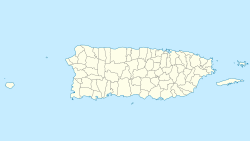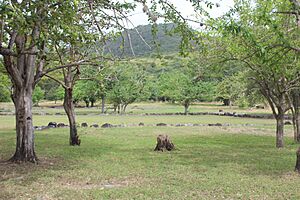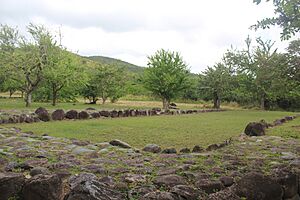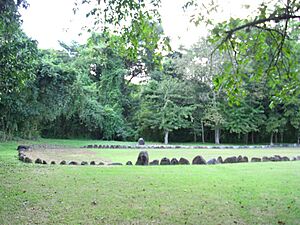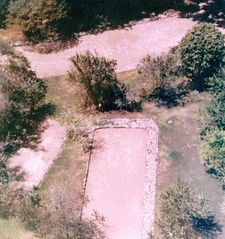Tibes Indigenous Ceremonial Center facts for kids
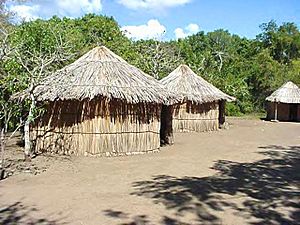
Taíno village at Tibes
|
|
| Established | 30 April 1982 |
|---|---|
| Location | Road PR-503 Sector La Vega de Taní Barrio Tibes Ponce, Puerto Rico |
| Type | Archeology museum |
| Visitors | 60,000–80,000 per year |
| Owner | Autonomous Municipality of Ponce |
|
Centro Ceremonial Indígena
|
|
| Area | 40 acres (16 ha) |
| MPS | Ball court/plaza sites of Puerto Rico and the U.S. Virgin Islands |
| NRHP reference No. | 78003381 |
| Added to NRHP | 14 April 1978 |
The Tibes Indigenous Ceremonial Center (which means "Indigenous Ceremonial Center of Tibes" in Spanish) is a very important historical place in Ponce, Puerto Rico. It holds one of the biggest archaeological finds in the Antilles, a group of islands in the Caribbean. This center helps us understand how the ancient Igneri and Taíno tribes lived and played long before Christopher Columbus arrived.
Tibes is the oldest known ceremonial and sports complex built by indigenous people in Puerto Rico. It also has the largest ancient cemetery found so far, with 186 human skeletons. Most of these are from the Igneri people, and some are from even older cultures. Scientists believe the way the ceremonial plazas are set up means it was also the oldest astronomical observatory in the Antilles. The center became a museum in 1982 and was updated in 1991.
Contents
What Makes Tibes So Special?
The Tibes Indigenous Ceremonial Center is one of the largest and most important ancient sites in all the Caribbean islands. It is the biggest ceremonial site in Puerto Rico. It shows us how people lived continuously from the Igneri times all the way to the Taíno times.
This site is like a giant puzzle for archaeologists. It helps them learn about the changes in culture and how different groups might have lived together or separately. The findings here help answer big questions about how the Igneri culture changed into the Taíno culture.
The site also gives clues about how people in the Caribbean might have been influenced by other cultures, like those from Mesoamerica (parts of Mexico and Central America). For example, the idea of playing ball games might have come from there as early as 700 AD. By studying the ancient trash heaps and burials, experts learn about what people ate, their health, and their beliefs.
More than 186 human skeletons were found at Tibes, making it the largest ancient cemetery in the area. Most of these remains belonged to the Igneri people. Scientists have even taken DNA samples to learn more about these ancient communities. From these discoveries, we've learned about their ceremonies, eating habits, and how they made pottery.
Today, the Tibes center is a popular place for visitors. It opened to the public on April 30, 1982. Many artifacts found at the site are on display in a museum there. You can also see some of them at the Ponce Museum of Art.
What Does the Site Look Like?
The Tibes Indigenous Ceremonial Center was found by accident after heavy rains in 1975. A group called the Guaynia Society of Archaeology and History explored the area. They cleared away thick bushes and found many ancient shell piles and, most importantly, the stone structures known as ball courts.
There are seven ball courts and one square plaza spread across the site. Five of the ball courts are rectangular, made with two parallel lines of flat stones. The other two ball courts are U-shaped, with paths paved with flat river stones and large rocks. Another interesting part of the site is a group of triangular stone shapes around a flat, dug-out area.
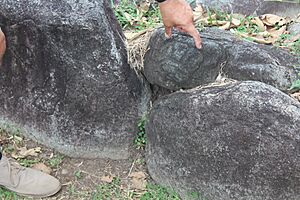
The main area is a nearly square enclosure called a plaza. It has paths paved with flat stones on two sides, and flat slabs on the other two. Many of the stones around the plaza have petroglyphs, which are ancient carvings. The ground inside the ball courts and plaza was changed by hand long ago.
Archaeologists dug test pits to figure out when people lived here. They found that the site was first used by the Igneri, who were some of the earliest farmers in the Caribbean. Using radiocarbon dating and studying pottery, they found that people lived here continuously from about 400 AD to 1000 AD. The last people to live at the site were likely the Taínos.
Life Before Columbus: Games and Celebrations
The Taínos lived in Puerto Rico before Christopher Columbus arrived in 1493. They enjoyed many games, some for fun and some for ceremonies. These included races, strength contests, and fishing. But the two most important sports were pretend warrior fights and ball games.
Body Strength Challenges
A Spanish historian named Pedro Martir de Angleria saw these games. He wrote that they were played in front of the whole village, with the "Cacique" (Chief) watching. Sometimes, a special guest would also be there. Two teams would pretend to fight with bows and arrows, defending their land like enemies. Angleria recorded one game where four men died and many were hurt in just one hour. The game would only stop when the Cacique gave a signal.
The Ball Game: Batey
The ball game was called "Batey," and it was played in a special ceremonial court, also called a "Batey". These courts were usually shaped like a triangle or a "U" and were in the middle of the village. The ball, called "Batu," was made of rubber and plant leaves, which made it bouncy.
Two teams played against each other, one on the west side and one on the east. Fathers and sons often played on opposite teams. The goal was to keep the ball moving all the time. Players could use their heads, elbows, shoulders, and knees, but not their hands. If the ball stopped moving, a team lost a point. Points were marked on the ground. The game ended when one team reached a certain number of points. Winners were celebrated, but the losing team faced serious consequences.
By the time the first Spanish settlers arrived, the game had changed a bit. Fray Bartolomé de las Casas described it this way: one team would serve the ball, and the other team would hit it back using anything but their hands. If the ball came at shoulder height, they'd hit it back very fast. If it came low, a player would quickly hit the ground and strike the ball with their backside. Play continued until someone made a mistake.
Areyto: Storytelling Through Dance
The Taínos had their own unique culture, traditions, and ways of governing. Besides playing ball games, they also used the plazas for special celebrations called "Areyto." An Areyto was a way to tell their history through singing and dancing, with music.
Most of what we know about Taíno traditions comes from the writings of Fray Bartolomé de las Casas. He described an Areyto as their way of passing history from person to person, from parents to children. He wrote that many people would gather, and the celebration could last three or four hours, or even from one day to the next, until the leader finished telling the story.
How Tibes Was Discovered
The Tibes site was found in 1975, right after Hurricane Eloise. That year, archaeologists from the Guaynia Society of Archaeology and History, along with members of the Archaeological Society of the Southwest, announced a big discovery. They had found the ruins of a "Batey" (ball court) in the Tibes area, just outside Ponce.
They found nine ball fields hidden under thick forest. These fields dated back to about 25 AD. The fields were different sizes, from about 12.8 meters (42 feet) long to 35.1 meters (115 feet) long.
Who Lived Here First?
Archaeologists believe the ball courts and ceremonial centers were built by the Igneri Culture. These were a group of people who lived before the Taínos. Modern science tells us that people lived in this area around 25 AD. The Igneri left the area around 600 AD for reasons we don't fully understand. The Taínos then moved into the same area around 1000 AD.
According to archaeologist Osvaldo Garcia Goyco, some of the plazas are lined up with the sun's position during the equinox and solstices. This makes sense because the Taínos planted their crops based on what they observed in the sky. This makes the Tibes Indigenous Ceremonial Center the oldest known astronomical observatory in the Caribbean.
What Happened When the Spanish Arrived?
When the Spanish came to Puerto Rico, one of the first things they did was try to make the Taínos become Christians. They thought the Taínos' ceremonies and religious practices were uncivilized. The Taínos were forced into slavery, made to build forts, and work in mines. Many died because of this harsh treatment and from diseases like smallpox that the Spanish brought to the island. However, before the Taíno tribes disappeared in Puerto Rico, Spanish historians like Fray Bartolomé de las Casas were able to see and write down many details about their lives and customs.
Ongoing Work at Tibes
Restoring and studying Tibes is a big job for archaeologists. Here are some things they are still working on:
- Only a small amount of archaeological work has been done so far, even though many stone structures have been uncovered.
- Much of the site still needs to be explored. More stone structures are known to exist outside the areas that have been cleared.
- Most past digs focused on small test pits, not larger areas.
- Previous work mainly looked at the ball courts. Archaeologists now want to explore the spaces between them, where old records suggest houses might have stood. Digging here could reveal where huts were built and where people threw away their trash.
- The pottery found at Tibes covers almost all of Puerto Rico's ceramic history. It's possible they might even find evidence of even older groups of people. No other similar site has such a long history of materials.
- Making a very detailed map of the area could show other hidden features, like artificial terraces (flat areas cut into hillsides).
See also
 In Spanish: Centro ceremonial indígena de Tibes para niños
In Spanish: Centro ceremonial indígena de Tibes para niños
- Ball Court/Plaza Sites of Puerto Rico and the U.S. Virgin Islands
- List of museums in Ponce, Puerto Rico
- National Register of Historic Places listings in Ponce, Puerto Rico
- List of archaeological sites sorted by country
- Taínos


